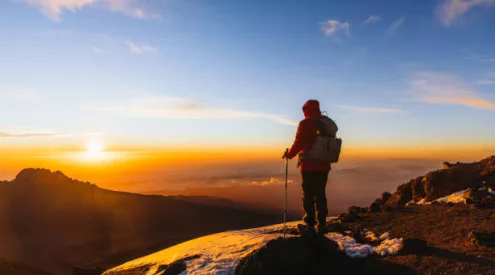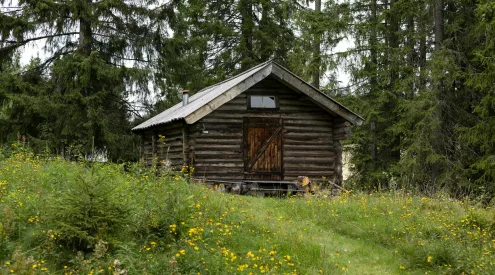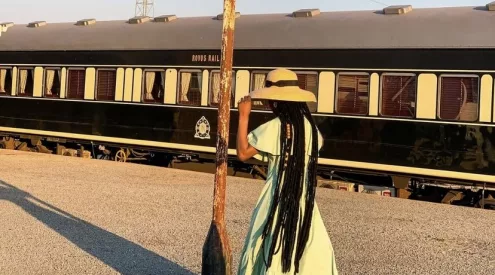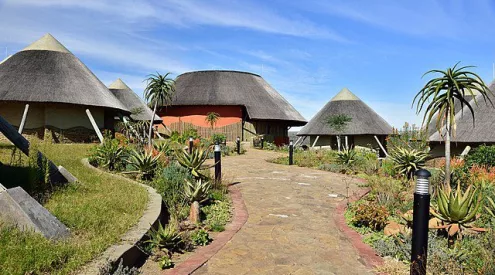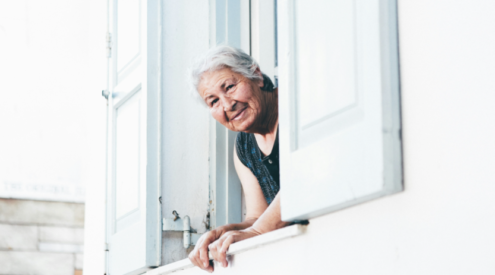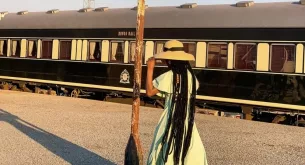The inaugural, luxurious Wild Flower Camp was assembled along the banks of the Berg River on Kersefontein Guest Farm, just outside Hopefield. Although the tented accommodation was virgin, the land on which it lay was not. For countless years the Cape’s West Coast has burst into a riot of colour as wildflowers bloom each spring – the multitude of petals flitting in the breeze like can-can girls’ skirts, beckons visitors to come and enjoy the show.

The bright and cheery colours of spring blooms on the Cape’s West Coast, on Kersefontein Guest Farm, near Hopefield. Image: Elise Kirsten
However, the two nights away was not just about flouncing in the flowers – although you are welcome to if you so desire. Organised by Pangae Tribe’s Andrew Bance, this curated experience is well worth the cost (pricing details below). Pangaea Tribe specializes in curating unique, immersive travel experiences by pairing the very best guides and specialists in various fields with exclusive locations throughout Southern Africa. I was impressed by not only the physical luxuries but the full experience that Pangaea Tribe put together for this first Wild Flower Camp – the days’ activities flowed as moothly as if the camp had been running for years.
The Wild Flower Camp team (made up of of such pundits) delivered a truly memorable couple of days. Ozzy Yerlikaya from Travel Designer was the designated ‘experience specialist’ and had a number of libatious tricks up his sleeve (more on that later). Chanté Bradfield, from Cape Living Collection took care of décor and cooked up fare with such wonderfully nuanced flavours in her veld kitchen, that when I finally left I had an overfull tummy and a recipe for my new favourite salad.
Another member of the five-star team was Kirsten Boswell, the camp concierge, who made sure that we felt welcome and more importantly that we had hot water bottles when we retired to our lavish tents at night. These were beautifully furnished, complete with a fluffy welcome mat, beds with puffy duvets, scatter cushions, and pretty fairy lights wound around the centre pole. There was also a private wooden-framed ablution room with a hot-water shower and portable, chemical toilet conveniently situated behind the tent.

Interior of one of the tents. Image: supplied.
When I first arrived at the farm’s typical Cape Dutch homestead, before heading to camp, I was welcomed with a refreshing botanical drink, while two mares and their foals grazed peacefully on the front lawn. Andrew then led us through the manor house for a fascinating tour. It didn’t take more than 30 minutes, yet was rich in historical significance with Andrew able to trace his own history and that of the farm (where he spent much time as a child) back nine generations to one of his enterprising ancestors, Martin Melck, who originated in East Prussia (present day Lithuania) and arrived South Africa in the 1700s.

Left: A welcome drink on arrival at the manor house at Kersefontein. Image: Elise Kirsten. Right: A fascinating tour of the private manor house, before setting off for the tented camp. Image: Willow Constantine
Today, the farm belongs to his uncle Julian Melck, who was on hand with a hearty welcome to lead those who had chosen to travel from the manor house to the tented camp by horseback. The rest of us were transported by 4×4.
Before reaching the camp, we stopped on top of a rise for a surprise sunset gin tasting, which Ozzy seemed to conjure up like a magician pulling a rabbit from a hat. He keeps a collapsible, wooden drinks bar (or cabinet) in the Thule storage box behind his Land Rover, which he swiftly set up in the veld. He served us delicious Musgrave gin, infused with rosemary and either grapefruit or lemon. I savoured the pink gin with its pleasant aroma of rose water, which reminded me of Turkish delight.

The guests on horseback arrived and Julian Melck ordered his drink (and enjoyed it) while still mounted on his steed. Then it was on to the camp, a couple of minutes drive away. Kirsten and Chanté greeted us at the veld kitchen where smoke from the fire curled lazily upwards into the evening sky. That night, after a hearty lamb potjie with lots of vegetables, some wine and malva pudding that followed, we sat chatting around the campfire, beneath a starry sky.

Sunset at the Wild Flower Camp. Image: Elise Kirsten
Despite the icy night air after recent snowfall on the Winterhoek and Matroosberg mountains in the distance, the tent was cosy and I snuggled up that night with my hot water bottle under a thick duvet and a pile of blankets. I had never slept on a proper bed inside a tent before and looking up at the sweeping cloth that gathered in the centre at the roof’s highest point, it felt like I had been transported to a previous era, of grand tented living.
This was a far cry from a blow-up mattress on the ground, under a thin layer of ripstop nylon, to which I’m more accustomed. I fell asleep to the sound of cows mooing, a strange but pleasant resonance for a suburban girl and I slept soundly that night. As I roused myself in the morning to the sound of a bird calls that I could not identify, there was a delivery of a flask of hot water, in case I wanted tea or coffee before heading to the veld kitchen.

The Wild Flower Tented Camp communal tent and veld kitchen. Image: Elise Kirsten
Breakfast of muesli, yoghurt and eggs on toast was accompanied by a coffee appreciation session with Ozzy (a passion of his), where he demonstrated his skill with enthusiasm, delivering a delicious cuppa from freshly roasted and ground Ethiopian coffee beans. Shortly afterwards Helene Preston, from The Custodians of Rare and Endangered Wildflowers CREW (a citizen science programme, supported by the Botanical Society of South Africa) arrived and was on hand for two days to enlighten us on the flora of the region and to lead two botanical walks.
A highlight of the wild flower glamping experience was the sunset cruise on the Berg river on the second evening, the boat parked within walking distance from the camp. We passed pelicans, red-billed coots and flocks of cormarants flew across the path of the sinking sun, as we enjoyed heavenly gin once more.

Cruising down the Berg River by boat, was an idyllic way to end the day. Image: Elise Kirsten
We headed back to camp afterwards for what I was so much more than ‘just’ a braai. The flavours of the marinades and the accompanying salads were mouthwateringly delectable and as we sat around the fire after supper with live guitar music wafting into the night air.
Also part of the Wild Flower Camp team, Dr Giselle Murison (project manager for the Western Cape Estuaries Conservation Project) spent time on day two enthralling the birders in the group, as the Berg River and Kersefontein’s estuary provides a haven for many species and this was the first identified breeding ground in the Western Cape of the Goliath heron, which we had the pleasure of spotting. Blue cranes abounded, as did pelican, glossy ibis, reed cormorant, red-knob coot, purple heron, and black-winged stilt to name just a few of the species.

Dr Giselle Murison looking at Goliath heron through her viewfinder. Image: Elise Kirsten Right: Great white pelicans. Image: Pixaby
The Wild Flower Camp team did a splendid job in seeing to our every need, while keeping us well fed and watered, informed and entertainened in a relaxing, natural environment. I was impressed by the team’s conservation-minded attitude. Everything was erected in a manner in which it could be removed without a trace afterwards and small but important environmental issues were taken care of, such as issuing us with glass bottles filled with water for our daily outings instead of the far from innocuous plastic ones.
The camp feels remote, as it lies on a swathe of land on the Berg River, with wetland, pans and surrounding farmland, but in actual fact, the farm is easily accessible. The entrance to the farm is 146km from Cape Town CBD and is less than 2 hours drive away, travelling on the N7 and then the R45 from Malmesbury to Hopefield.
For more information about the Wild Flower Camp visit wildflowercamp.com or contact Pangaea Tribe.
Cost
International rate: R3,390 per person per night sharing, R4,068 single supplement, R2,712 per child 12-18yrs
South African residents: R2,999 per person sharing (minumum of 2 nights), single supplement R3,599. Children 12-18 R2,399 (no under 12s allowed).
Price is inclusive of all meals and snack platters, craft gin experiences, coffee appreciation, river cruise, horse ride (optional), 4×4 transfers, coffee, tea, spring water and professional guide fees.

Left: Bokbaaivygie( Dorotheanthus bellidiformis) also known as the Livingstone daisy. Right: Helene Preston, a citizen scientist, verifies the identity of a plant using a field guide.

